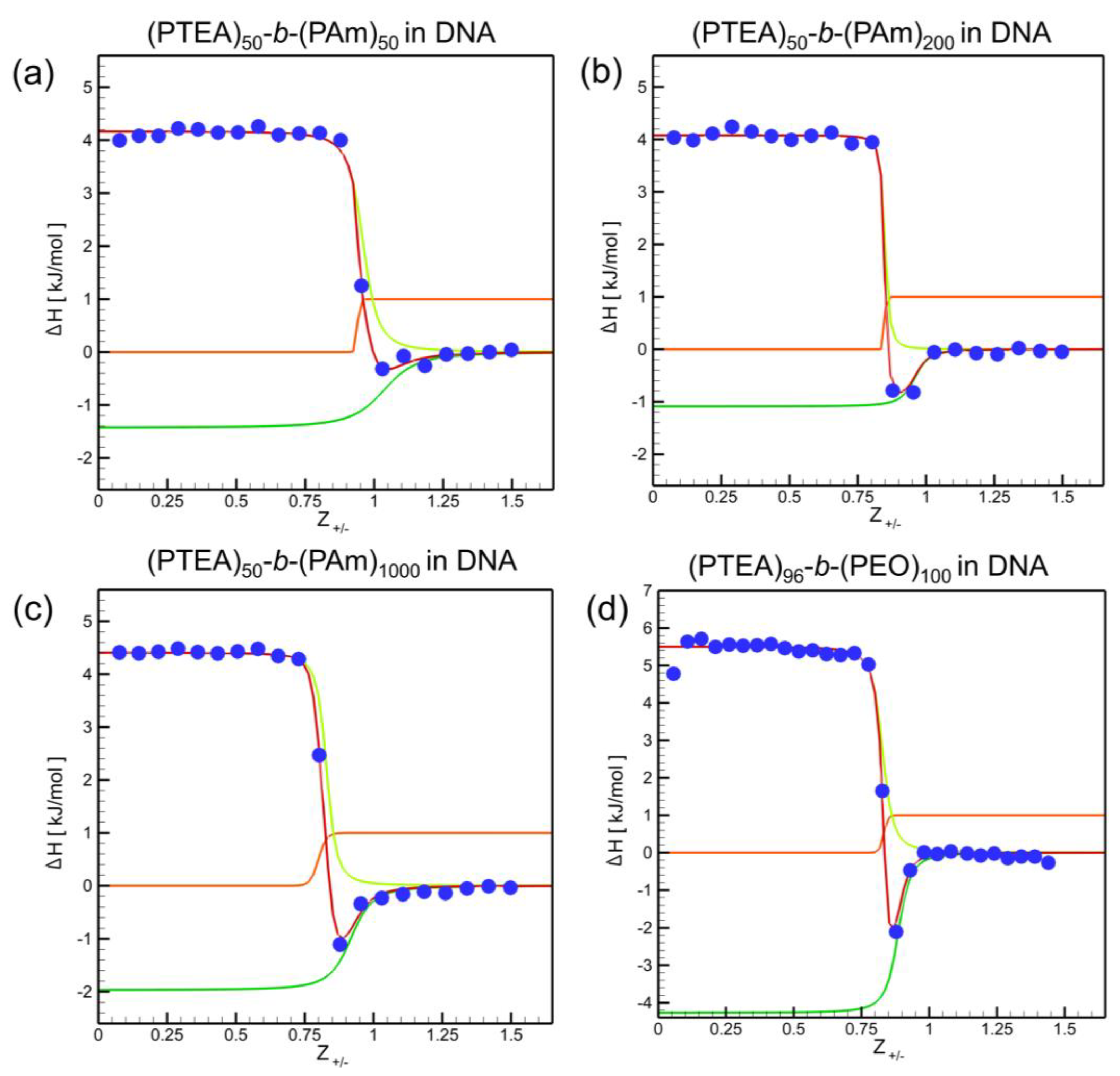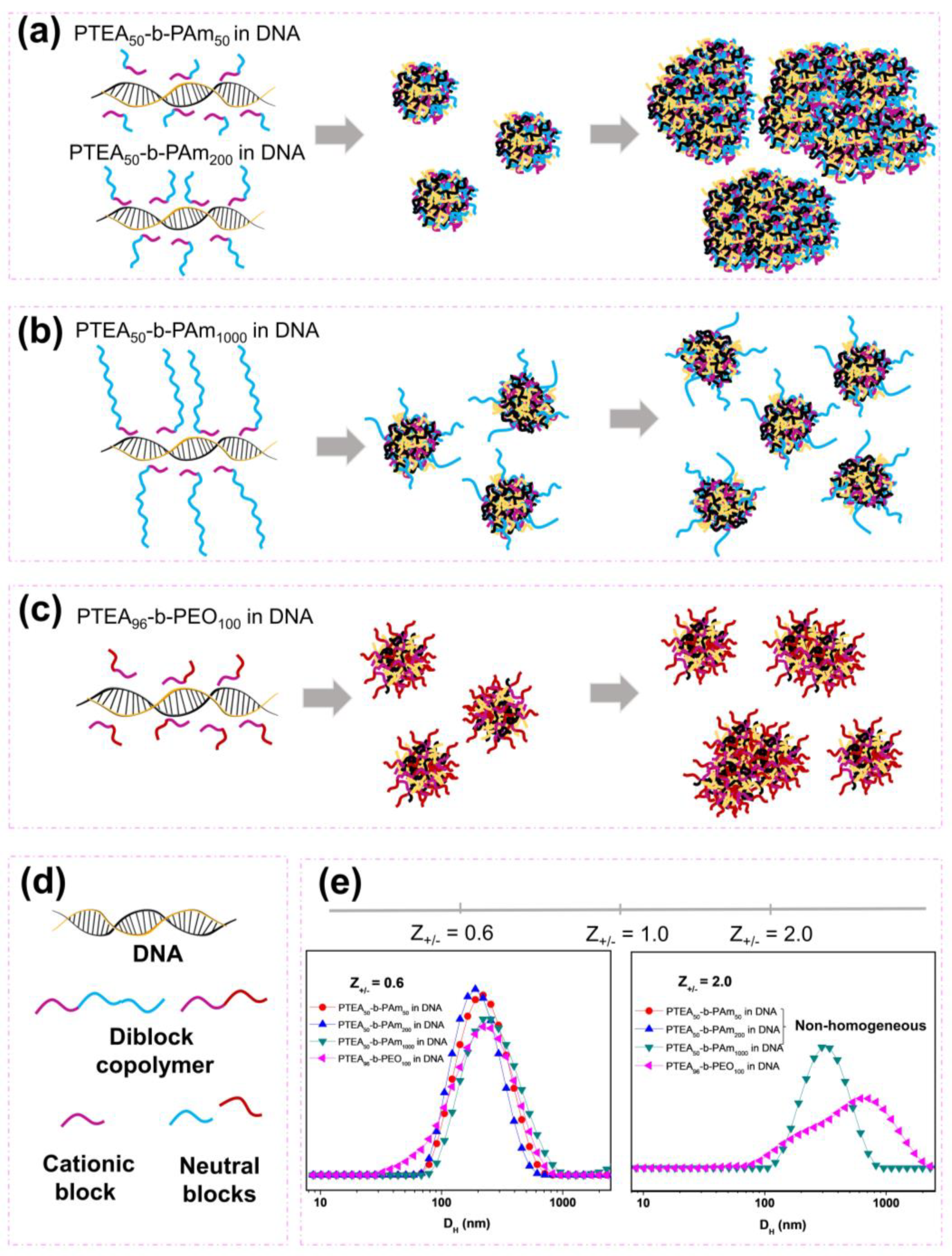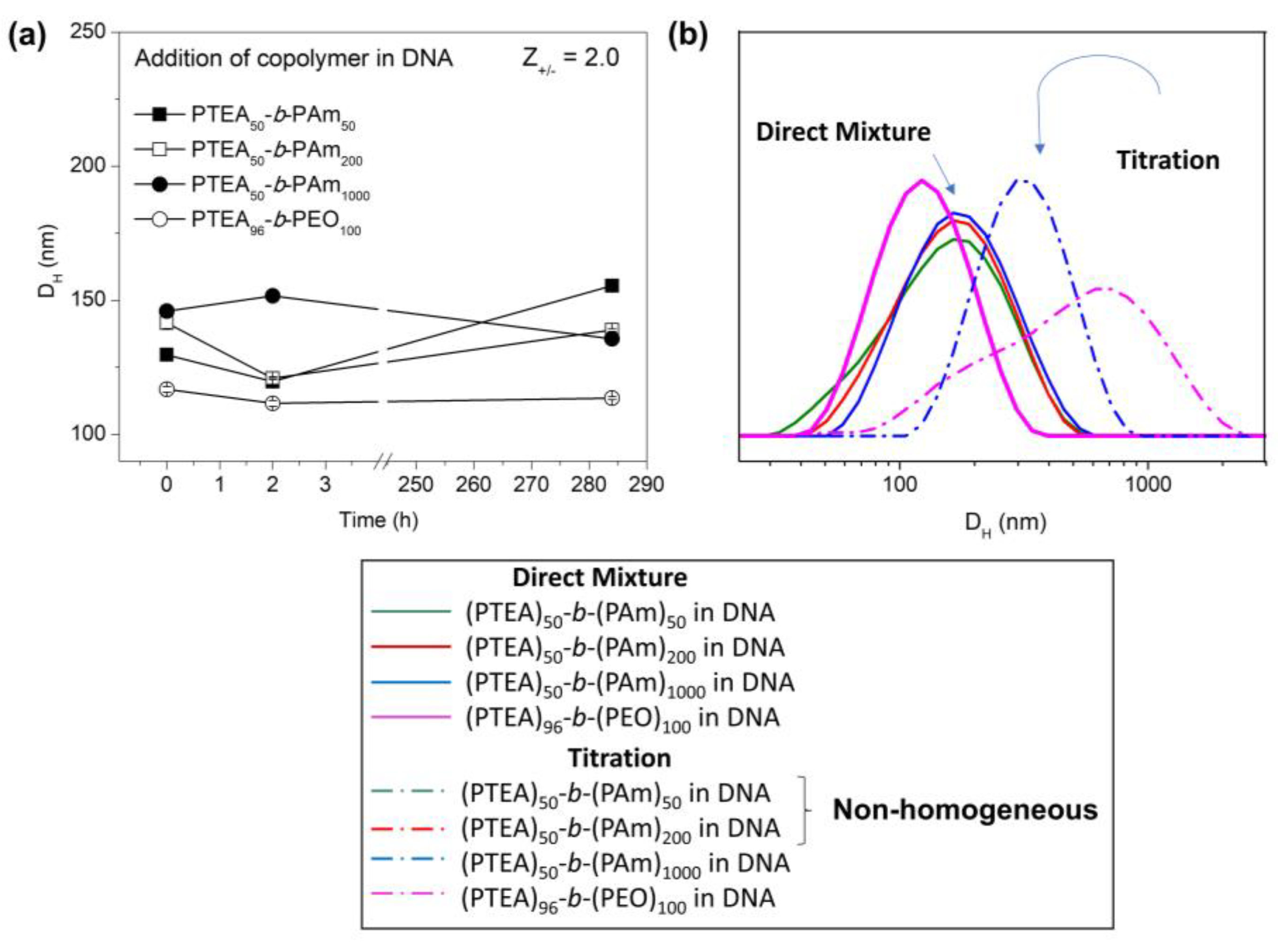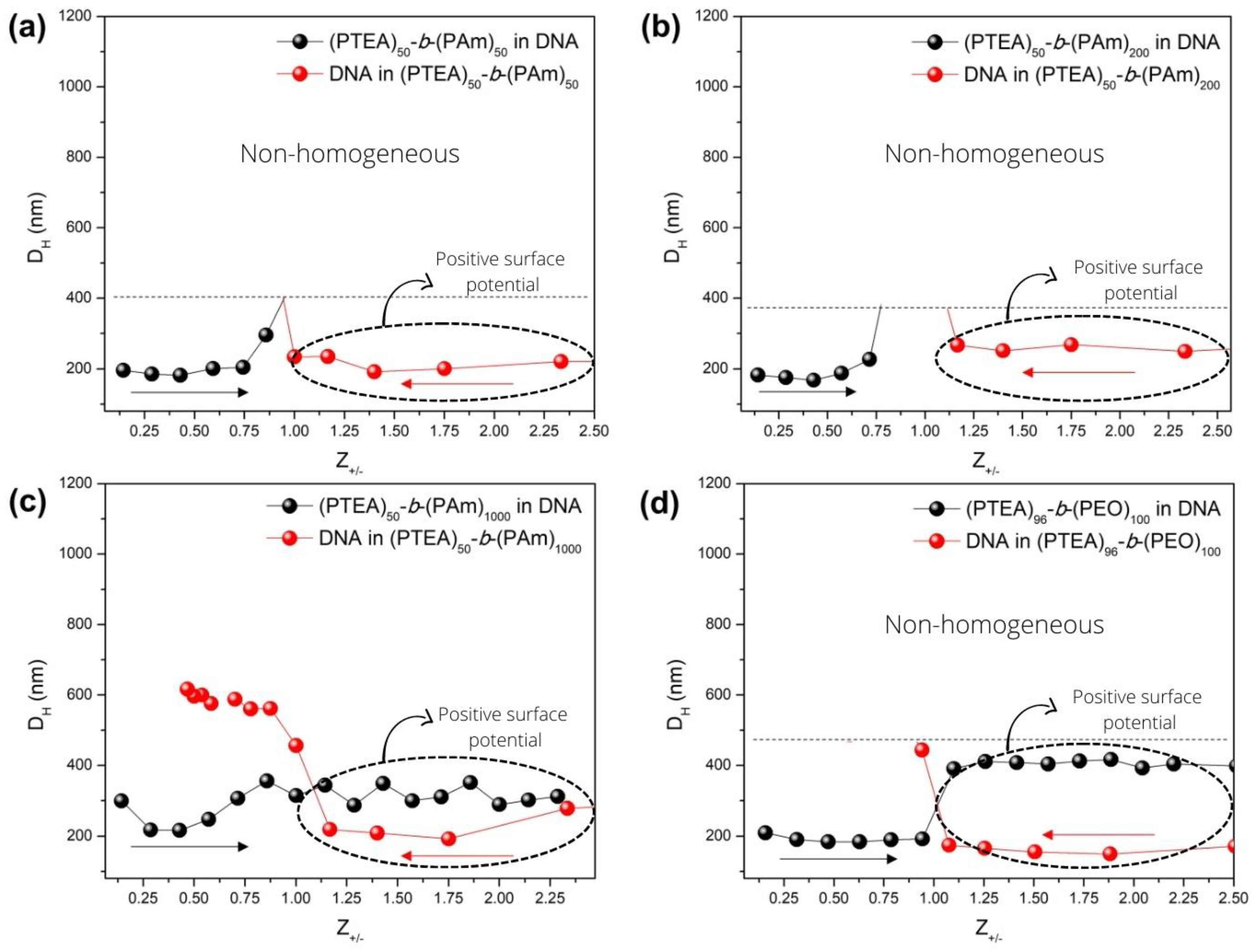Assessing the Contribution of the Neutral Blocks in DNA/Block-Copolymer Polyplexes: Poly(acrylamide) vs. Poly(ethylene Oxide)
Abstract
:1. Introduction
2. Results and Discussion
3. Materials and Methods
3.1. Materials
3.2. Block Copolymer Synthesis
3.2.1. Preparation of RAFT Agent (CTA)
3.2.2. Preparation of Homopolymer Poly(trimethyl-ammonium Chloride Metacriloiloxietil) and Block Copolymers PTEA-b-PAm
3.2.3. Modification of (PTEA)-b-(PEO)
3.3. Polyplexes Preparation
3.4. Isothermal Titration Calorimetry
3.5. Dynamic Light-Scattering and Zeta Potential Measurements
3.6. Circular Dichroism (CD)
4. Conclusions
Supplementary Materials
Author Contributions
Funding
Data Availability Statement
Acknowledgments
Conflicts of Interest
Sample Availability
References
- Chen, X.M.; Feng, W.J.; Bisoyi, H.K.; Zhang, S.; Chen, X.; Yang, H.; Li, Q. Light-Activated Photodeformable Supramolecular Dissipative Self-Assemblies. Nat. Commun. 2022, 13, 3216. [Google Scholar] [CrossRef] [PubMed]
- Chen, X.M.; Hou, X.F.; Bisoyi, H.K.; Feng, W.J.; Cao, Q.; Huang, S.; Yang, H.; Chen, D.; Li, Q. Light-Fueled Transient Supramolecular Assemblies in Water as Fluorescence Modulators. Nat. Commun. 2021, 12, 4993. [Google Scholar] [CrossRef] [PubMed]
- Huang, D.; Korolev, N.; Eom, K.D.; Tam, J.P.; Nordenskiöld, L. Design and Biophysical Characterization of Novel Polycationic E-Peptides for DNA Compaction and Delivery. Biomacromolecules 2008, 9, 321–330. [Google Scholar] [CrossRef] [PubMed]
- Nisha, C.K.; Manorama, S.V.; Ganguli, M.; Maiti, S.; Kizhakkedathu, J.N. Complexes of Poly(Ethylene Glycol)-Based Cationic Random Copolymer and Calf Thymus DNA: A Complete Biophysical Characterization. Langmuir 2004, 20, 2386–2396. [Google Scholar] [CrossRef] [PubMed]
- Insua, I.; Wilkinson, A.; Fernandez-Trillo, F. Polyion Complex (PIC) Particles: Preparation and Biomedical Applications. Eur. Polym. J. 2016, 81, 198–215. [Google Scholar] [CrossRef] [PubMed] [Green Version]
- St. John, P.M.; Westervelt, K.; Rimawi, A.; Kawakita, T. Binding between an Amine Cationic Surfactant and DNA and Surface Properties of the Resultant Aggregates. Biophys. Chem. 2022, 281, 106734. [Google Scholar] [CrossRef]
- Barreleiro, P.C.A.; Olofsson, G.; Alexandridis, P. Interaction of DNA with Cationic Vesicles: A Calorimetric Study. J. Phys. Chem. B 2000, 104, 7795–7802. [Google Scholar] [CrossRef]
- Akram, M.; Lal, H. Kabir-ud-Din Exploring the Binding Mode of Ester-Based Cationic Gemini Surfactants with Calf Thymus DNA: A Detailed Physicochemical, Spectroscopic and Theoretical Study. Bioorg. Chem. 2022, 119, 105555. [Google Scholar] [CrossRef]
- Petersen, H.; Kunath, K.; Martin, A.L.; Stolnik, S.; Roberts, C.J.; Davies, M.C.; Kissel, T. Star-Shaped Poly(Ethylene Glycol)-Block-Polyethlenimine Copolymers Enhance DNA Condensation of Low Molecular Weight Polyethylenimines. Biomacromolecules 2002, 3, 926–936. [Google Scholar] [CrossRef]
- Bellettini, I.C.; Fayad, S.J.; Machado, V.G.; Minatti, E. Properties of Polyplexes Formed through Interaction between Hydrophobically-Modified Poly(Ethylene Imine)s and Calf Thymus DNA in Aqueous Solution. Soft Matter 2017, 13, 2609–2619. [Google Scholar] [CrossRef]
- Sabín, J.; Alatorre-Meda, M.; Miñones, J.; Domínguez-Arca, V.; Prieto, G. New Insights on the Mechanism of Polyethylenimine Transfection and Their Implications on Gene Therapy and DNA Vaccines. Colloids Surf. B Biointerfaces 2021, 210, 112219. [Google Scholar] [CrossRef] [PubMed]
- Eldred, S.E.; Pancost, M.R.; Otte, K.M.; Rozema, D.; Stahl, S.S.; Gellman, S.H. Effects of Side Chain Configuration and Backbone Spacing on the Gene Delivery Properties of Lysine-Derived Cationic Polymers. Bioconjugate Chem. 2005, 16, 694–699. [Google Scholar] [CrossRef] [PubMed]
- Veleva-kostadinova, E.; Dimitrov, I.; Toncheva-moncheva, N.; Novakov, C.; Momekova, D.; Rangelov, S. Nanoparticulate Polyelectrolyte Complexes of Thermally Sensitive Poly(L-Lysine)-Based Copolymers and DNA. Eur. Polym. J. 2018, 102, 219–230. [Google Scholar] [CrossRef]
- Prevette, L.E.; Kodger, T.E.; Reineke, T.M.; Lynch, M.L. Deciphering the Role of Hydrogen Bonding in Enhancing PDNA-Polycation Interactions. Langmuir 2007, 23, 9773–9784. [Google Scholar] [CrossRef]
- Molina-pinilla, I.; Hakkou, K.; Romero-azogil, L.; Benito, E.; García-martín, M.G.; Bueno-martínez, M. Synthesis of Degradable Linear Cationic Poly(Amide Triazole)s with DNA-Condensation Capability. Eur. Polym. J. 2019, 113, 36–46. [Google Scholar] [CrossRef]
- Braun, C.S.; Vetro, J.A.; Tomalia, D.A.; Koe, G.S.; Koe, J.G.; Middaugh, C.R. Structure/Function Relationships of Polyamidoamine/DNA Dendrimers as Gene Delivery Vehicles. J. Pharm. Sci. 2005, 94, 423–436. [Google Scholar] [CrossRef]
- Örberg, M.-L.; Schillén, K.; Nylander, T. Dynamic Light Scattering and Fluorescence Study of the Interaction between Double-Stranded DNA and Poly (Amido Amine) Dendrimers. Biomacromolecules 2007, 8, 1557–1563. [Google Scholar] [CrossRef]
- Cárdenas, M.; Schillén, K.; Pebalk, D.; Nylander, T.; Lindman, B. Interaction between DNA and Charged Colloids Could Be Hydrophobically Driven. Biomacromolecules 2005, 6, 832–837. [Google Scholar] [CrossRef]
- Franck, C.O.; Fanslau, L.; Popov, A.B.; Tyagi, P.; Fruk, L. Biopolymer-Based Carriers for DNA Vaccine Design. Angew. Chem. Int. Ed. 2021, 60, 13225–13243. [Google Scholar] [CrossRef]
- Albuquerque, L.J.C.; Annes, K.; Milazzotto, M.P.; Mattei, B.; Riske, K.A.; Jäger, E.; Pánek, J.; Štěpánek, P.; Kapusta, P.; Muraro, P.I.R.; et al. Efficient Condensation of DNA into Environmentally Responsive Polyplexes Produced from Block Catiomers Carrying Amine or Diamine Groups. Langmuir 2016, 32, 577–586. [Google Scholar] [CrossRef]
- Jung, S.; Lodge, T.P.; Reineke, T.M. Structures and Protonation States of Hydrophilic–Cationic Diblock Copolymers and Their Binding with Plasmid DNA. J. Phys. Chem. B 2018, 122, 2449–2461. [Google Scholar] [CrossRef] [PubMed]
- Chen, B.; Yu, L.; Li, Z.; Wu, C. Design of Free Triblock Polylysine-b-Polyleucine-b-Polylysine Chains for Gene Delivery. Biomacromolecules 2018, 19, 1347–1357. [Google Scholar] [CrossRef] [PubMed]
- Funhoff, A.M.; Van Nostrum, C.F.; Lok, M.C.; Fretz, M.M.; Crommelin, D.J.A.; Hennink, W.E. Poly(3-Guanidinopropyl Methacrylate): A Novel Cationic Polymer for Gene Delivery. Bioconjugate Chem. 2004, 15, 1212–1220. [Google Scholar] [CrossRef] [PubMed]
- Nimesh, S.; Chandra, R. Guanidinium-Grafted Polyethylenimine: An Efficient Transfecting Agent for Mammalian Cells. Eur. J. Pharm. Biopharm. 2008, 68, 647–655. [Google Scholar] [CrossRef] [PubMed]
- Jung, S.; Lodge, T.P.; Reineke, T.M. Complexation between DNA and Hydrophilic-Cationic Diblock Copolymers. J. Phys. Chem. B 2017, 121, 2230–2243. [Google Scholar] [CrossRef]
- Alatorre-Meda, M.; Taboada, P.; Krajewska, B.; Willemeit, M.; Deml, A.; Klösel, R.; Rodríguez, J.R. DNA-Poly(Diallyldimethylammonium Chloride) Complexation and Transfection Efficiency. J. Phys. Chem. B 2010, 114, 9356–9366. [Google Scholar] [CrossRef]
- Haladjova, E.; Mountrichas, G.; Pispas, S.; Rangelov, S. Poly(Vinyl Benzyl Trimethylammonium Chloride) Homo and Block Copolymers Complexation with DNA. J. Phys. Chem. B 2016, 120, 2586–2595. [Google Scholar] [CrossRef]
- Sharma, R.; Lee, J.S.; Bettencourt, R.C.; Xiao, C.; Konieczny, S.F.; Won, Y.Y. Effects of the Incorporation of a Hydrophobic Middle Block into a PEG-Polycation Diblock Copolymer on the Physicochemical and Cell Interaction Properties of the Polymer-DNA Complexes. Biomacromolecules 2008, 9, 3294–3307. [Google Scholar] [CrossRef] [Green Version]
- Knaapila, M.; Costa, T.; Garamus, V.M.; Kraft, M.; Drechsler, M.; Scherf, U.; Burrows, H.D. Polyelectrolyte Complexes of a Cationic All Conjugated Fluorene-Thiophene Diblock Copolymer with Aqueous DNA. J. Phys. Chem. B 2015, 119, 3231–3241. [Google Scholar] [CrossRef]
- Dootz, R.; Toma, A.C.; Pfohl, T. PAMAM6 Dendrimers and DNA: PH Dependent “Beads-on-a-String” Behavior Revealed by Small Angle X-Ray Scattering. Soft Matter 2011, 7, 8343–8351. [Google Scholar] [CrossRef]
- Jiang, Y.; Reineke, T.M.; Lodge, T.P. Complexation of DNA with Cationic Copolymer Micelles: Effects of DNA Length and Topology. Macromolecules 2018, 51, 1150–1160. [Google Scholar] [CrossRef]
- Ping, Y.; Ding, D.; Ramos, R.A.N.S.; Mohanram, H.; Deepankumar, K.; Gao, J.; Tang, G.; Miserez, A. Supramolecular β-Sheets Stabilized Protein Nanocarriers for Drug Delivery and Gene Transfection. ACS Nano 2017, 11, 4528–4541. [Google Scholar] [CrossRef] [PubMed]
- Pandey, A.P.; Sawant, K.K. Polyethylenimine: A Versatile, Multifunctional Non-Viral Vector for Nucleic Acid Delivery. Mater. Sci. Eng. C 2016, 68, 904–918. [Google Scholar] [CrossRef] [PubMed]
- Alvarez-Lorenzo, C.; Barreiro-Iglesias, R.; Concheiro, A.; Iourtchenko, L.; Alakhov, V.; Bromberg, L.; Temchenko, M.; Deshmukh, S.; Hatton, T.A. Biophysical Characterization of Complexation of DNA with Block Copolymers of Poly(2-Dimethylaminoethyl) Methacrylate, Poly(Ethylene Oxide), and Poly(Propylene Oxide). Langmuir 2005, 21, 5142–5148. [Google Scholar] [CrossRef]
- Herrera, I.; Winnik, M.A. Differential Binding Models for Isothermal Titration Calorimetry: Moving beyond the Wiseman Isotherm. J. Phys. Chem. B 2013, 117, 8659–8672. [Google Scholar] [CrossRef] [PubMed]
- Lounis, F.M.; Chamieh, J.; Leclercq, L.; Gonzalez, P.; Geneste, A.; Prelot, B.; Cottet, H. Interactions between Oppositely Charged Polyelectrolytes by Isothermal Titration Calorimetry: Effect of Ionic Strength and Charge Density. J. Phys. Chem. B 2017, 121, 2684–2694. [Google Scholar] [CrossRef]
- Olofsson, G.; Loh, W. On the Use of Titration Calorimetry to Study the Association of Surfactants in Aqueous Solutions. J. Braz. Chem. Soc. 2009, 20, 577–593. [Google Scholar] [CrossRef] [Green Version]
- Vitorazi, L.; Ould-Moussa, N.; Sekar, S.; Fresnais, J.; Loh, W.; Chapel, J.P.; Berret, J.F. Evidence of a Two-Step Process and Pathway Dependency in the Thermodynamics of Poly(Diallyldimethylammonium Chloride)/Poly(Sodium Acrylate) Complexation. Soft Matter 2014, 10, 9496–9505. [Google Scholar] [CrossRef] [Green Version]
- Cingil, H.E.; Boz, E.B.; Wang, J.; Stuart, M.A.C.; Sprakel, J. Probing Nanoscale Coassembly with Dual Mechanochromic Sensors. Adv. Funct. Mater. 2016, 26, 1420–1427. [Google Scholar] [CrossRef]
- Priftis, D.; Laugel, N.; Tirrell, M. Thermodynamic Characterization of Polypeptide Complex Coacervation. Langmuir 2012, 28, 15947–15957. [Google Scholar] [CrossRef]
- Skandalis, A.; Uchman, M.; Štěpánek, M.; Kerelche, S.; Pispas, S. Complexation of DNA with QPDMAEMA-b-PLMA-b-POEGMA Cationic Triblock Terpolymer Micelles. Macromolecules 2020. [Google Scholar] [CrossRef]
- Matulis, D.; Rouzina, I.; Bloomfield, V.A. Thermodynamics of DNA Binding and Condensation: Isothermal Titration Calorimetry and Electrostatic Mechanism. J. Mol. Biol. 2000, 296, 1053–1063. [Google Scholar] [CrossRef] [PubMed] [Green Version]
- Kim, W.; Yamasaki, Y.; Kataoka, K. Development of a Fitting Model Suitable for the Isothermal Titration Calorimetric Curve of DNA with Cationic Ligands. J. Phys. Chem. B 2006, 110, 10919–10925. [Google Scholar] [CrossRef] [PubMed]
- Vitorazi, L.; Berret, J.F.; Loh, W. Self-Assembly of Complex Salts of Cationic Surfactants and Anionic-Neutral Block Copolymers. Dispersions with Liquid-Crystalline Internal Structure. Langmuir 2013, 29, 14024–14033. [Google Scholar] [CrossRef] [Green Version]
- Machtakova, M.; Thérien-Aubin, H.; Landfester, K. Polymer Nano-Systems for the Encapsulation and Delivery of Active Biomacromolecular Therapeutic Agents. Chem. Soc. Rev. 2022, 51, 128–152. [Google Scholar] [CrossRef]
- Maruyama, A.; Watanabe, H.; Ferdous, A.; Katoh, M.; Ishihara, T.; Akaike, T. Characterization of Interpolyelectrolyte Complexes between Double-Stranded DNA and Polylysine Comb-Type Copolymers Having Hydrophilic Side Chains. Bioconjugate Chem. 1998, 9, 292–299. [Google Scholar] [CrossRef]
- Pound, G.; Eksteen, Z.; Pfukwa, R.; Mckenzie, J.M.; Lange, R.F.M.; Klumperman, B. Unexpected Reactions Associated with the Xanthate-Mediated Polymerization of N-Vinylpyrrolidone. J. Polym. Sci. Part A. Polym. Chem. 2008, 46, 6575–6593. [Google Scholar] [CrossRef]
- Taton, D.; Wilczewska, A.Z.; Destarac, M. Direct Synthesis of Double Hydrophilic Statistical Di- and Triblock Copolymers Comprised of Acrylamide and Acrylic Acid Units via the MADIX Process. Macromol. Rapid Commun. 2001, 22, 1497–1503. [Google Scholar] [CrossRef]
- Lowe, A.B.; McCormick, C.L. Reversible Addition-Fragmentation Chain Transfer (RAFT) Radical Polymerization and the Synthesis of Water-Soluble (Co)Polymers under Homogeneous Conditions in Organic and Aqueous Media. Prog. Polym. Sci. 2007, 32, 283–351. [Google Scholar] [CrossRef]
- Ranger, M.; Jones, M.; Yessine, M.-A.; Leroux, J.-C. From Well-Defined Diblock Copolymers Prepared by a Versatile Atom Transfer Radical Polymerization Method to Supramolecular Assemblies. J. Polym. Sci. A Polym. Chem. 2001, 39, 3861–3874. [Google Scholar] [CrossRef]









| Number of Monomers of Cationic Block | Mw, Cationic Block (g mol−1) | Number of Monomers of Neutral block | Mw, Neutral Block (g mol−1) | Dispersity (Mw/Mn) | |
|---|---|---|---|---|---|
| (PTEA)50-b-(PAm)50 | 50 | 10,581 | 50 | 3550 | 1.5 * |
| (PTEA)50-b-(PAm)200 | 50 | 10,203 | 200 | 14,200 | 1.9 * |
| (PTEA)50-b-(PAm)1000 | 50 | 10,526 | 1000 | 71,000 | 2.3 * |
| (PDMAEMA)96-b-(PEO)100 | 96 | 15,000 | 113 | 5000 | 1.3 ** |
| (PTEA)96-b-(PEO)100 | 96 | 28,695 | 113 | 5000 | 1.3 ** |
| Process A | (kJ mol−1) | (kJ mol−1) | (J mol−1 K−1) | ||
|---|---|---|---|---|---|
| PTEA50-b-PAm50 in DNA | 4.2 | 3.1 × 106 | 0.96 | −37.0 | 138 |
| PTEA50-b-PAm200 in DNA | 4.1 | 2.5 × 107 | 0.85 | −42.2 | 155 |
| PTEA50-b-PAm1000 in DNA | 4.4 | 6.3 × 106 | 0.83 | −38.8 | 145 |
| PTEA96-b-PEO100 in DNA | 5.5 | 5.0 × 106 | 0.83 | −38.2 | 147 |
| Process C | (kJ mol−1) | (kJ mol−1) | (J mol−1 K−1) | ||
| PTEA50-b-PAm50 in DNA | −1.4 | 6.6 × 105 | 1.04 | −33.2 | 107 |
| PTEA50-b-PAm200 in DNA | −1.1 | 3.1 × 106 | 0.96 | −37.1 | 121 |
| PTEA50-b-PAm1000 in DNA | −2.0 | 1.4 × 106 | 0.92 | −35.1 | 111 |
| PTEA96-b-PEO100 in DNA | −4.3 | 1.4 × 106 | 0.89 | −35.0 | 103 |
Disclaimer/Publisher’s Note: The statements, opinions and data contained in all publications are solely those of the individual author(s) and contributor(s) and not of MDPI and/or the editor(s). MDPI and/or the editor(s) disclaim responsibility for any injury to people or property resulting from any ideas, methods, instructions or products referred to in the content. |
© 2023 by the authors. Licensee MDPI, Basel, Switzerland. This article is an open access article distributed under the terms and conditions of the Creative Commons Attribution (CC BY) license (https://creativecommons.org/licenses/by/4.0/).
Share and Cite
Giona, R.M.; Vitorazi, L.; Loh, W. Assessing the Contribution of the Neutral Blocks in DNA/Block-Copolymer Polyplexes: Poly(acrylamide) vs. Poly(ethylene Oxide). Molecules 2023, 28, 398. https://doi.org/10.3390/molecules28010398
Giona RM, Vitorazi L, Loh W. Assessing the Contribution of the Neutral Blocks in DNA/Block-Copolymer Polyplexes: Poly(acrylamide) vs. Poly(ethylene Oxide). Molecules. 2023; 28(1):398. https://doi.org/10.3390/molecules28010398
Chicago/Turabian StyleGiona, Renata Mello, Letícia Vitorazi, and Watson Loh. 2023. "Assessing the Contribution of the Neutral Blocks in DNA/Block-Copolymer Polyplexes: Poly(acrylamide) vs. Poly(ethylene Oxide)" Molecules 28, no. 1: 398. https://doi.org/10.3390/molecules28010398







